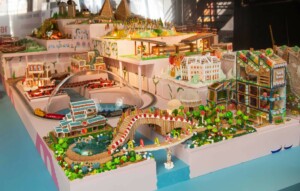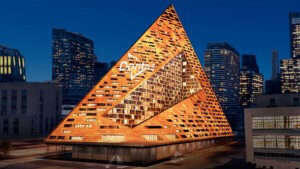What does Bompas & Parr do? If you have the foggiest, perhaps the name should hint at the bizarre ideas its two founders, Sam Bompas and Harry Parr, are notorious for brewing up. If you hadn’t somehow guessed, the South London pair make architectural jellies, clouds of gin, and breast bouncy castles, among other things, and have been mixing architecture with our often architecturally shunned senses—especially in the form of desserts—for almost a decade (their ten-year anniversary is next month).
Parr and Bompas met at the tender age of 13 while playing in the same orchestra at Eton. Since then, they have become experts in multi-sensory experiences. Parr, an architect by training, spoke at Brooklyn’s A/D/O recently about how we taste and smell, part of the ongoing Common Sense program. In one experiment, he proved how, through genetics, we all have genuinely different tastes. In another, he played different sounds as the audience ate two chocolates. Which one tasted sweeter? Of course, the chocolates were both the same, but the nostalgic sound of children kicked our brain—and sweet tooth into gear.
After being subjected to these experiments, The Architect’s Newspaper (AN) caught up with Parr to talk more about his firm and his fascination with the senses.
AN: So why jelly?
Parr: Initially attracted by the nostalgia and visual appeal of jelly we tried to get a jelly stall at London’s Borough Market. Although that failed, we did start to discover that jelly has an intriguing history and it is a powerful, albeit unusual design tool. Over the centuries jelly molds have changed, [with] material and design keeping up with the latest technologies and trends. Henry the VIII had jellies made in sycamore molds, whilst the Victorians preferred electroformed copper. Glass, ceramics, aluminum, and plastic have also been used.
The realization that I could make my own molds using 3D printing allowed us to create an infinite variety of shapes which we could then combine with an infinite variety of colors and flavors. This creates a fascinating vehicle for discovering how people interact with food—especially in looking at flavor perception.
At A/D/O you did a couple of experiments. What got you into exploring how external associations and preconceptions affect our senses?
Whilst working on our first commissioned project, the 12-course Victorian Breakfast, I realized that the environment was directly impacting on how people perceive their food. In this case, an ornate state dining room combined with polished silverware, Victorian fairground tunes (which happened to be coming from a funfair outside), and waiters in Victorian garb somehow combined together to make people have a great experience. We were surprised when one of our guests asked for a recipe for the scones which we had bought a few hours earlier from Tesco!
How did you go from making fabulous jelly to where you are now?
We rapidly started exploring how the work that we had done with jelly could be applied to different sorts of food and how we could create unusual food-centered experiences. The result of this was that we started designing, funding, and promoting our own events. The first major event was Alcoholic Architecture.
Alcoholic Architecture—whose idea was that? How did you manage to pull it off?
We were inspired by Anthony Gormley’s exhibit Blind Light which was on at the Hayward Gallery. We felt it would be far better if the cloud was made from alcohol than water vapor, so we set about developing the technology and working with a scientist to see how we could do this safely.
Have you ever had people react badly or in an unexpected way to your sensual concoctions?
We’ve had a few people fall into the water by getting stuck under a waterfall in our Beyond the Waterfall adventure. We are very interested in the risk and reward mechanism, so we often encourage people to go beyond their comfort zones and usually it’s very rewarding for them.
In 2015 Bompas & Parr created Funland for the Museum of Sex in New York. How did you come up with ideas for that?
The project grew out of a commission by the museum for Jump Joy (a breast bouncy castle). As part of out research, we started working with Professor Vanessa Toulmin of the National Fairground Archive. This uncovered a deep historical link between carnivals and sex. The result was a selection of carnival inspired attractions for audiences to enjoy and experience while they contemplate the sexual subtext of the rides. We are now working on new version of Funland for the museum.
What’s next for Bompas & Parr?
In June we celebrate our tenth anniversary, and as part of this the São Paulo Museum of Modern Art is hosting a retrospective, entitled Tongue Town which will run for three months. It will feature some of our early work, including a stomach bouncy castle, a fruit cloud, and display exploring the working practices of the studio.










